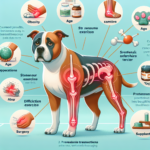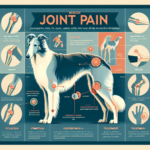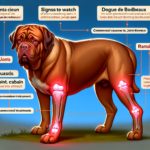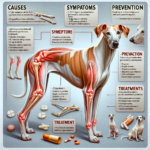Doberman Pinscher Joint Pain: Causes, Symptoms, Prevention, and Treatment

Introduction
The Doberman Pinscher, often simply referred to as the Doberman, is a breed known for its intelligence, loyalty, and athleticism. Originating in Germany in the late 19th century, the breed was developed by Karl Friedrich Louis Dobermann, a tax collector who sought a loyal and protective companion. Dobermans are characterized by their sleek, muscular build, short coat, and distinctive markings. They are often employed in roles such as police and military work, search and rescue, and as loyal family pets.
While Dobermans are generally healthy dogs, they are prone to certain health issues, including heart problems, hypothyroidism, and joint-related conditions. Joint pain is a significant concern for Doberman owners, as it can severely impact the dog’s quality of life and mobility.
Maintaining joint health is crucial for Dobermans due to their active lifestyle and genetic predispositions. Joint issues can lead to chronic pain, reduced mobility, and a decreased ability to perform tasks or enjoy physical activities. Understanding the causes, symptoms, prevention, and treatment of joint pain in Dobermans is essential for ensuring their well-being.
Breed-Specific Joint Pain Risks
Genetic Predisposition
Dobermans are genetically predisposed to several joint-related issues, including hip dysplasia, arthritis, and elbow dysplasia. Hip dysplasia is a condition where the hip joint does not fit properly into the hip socket, leading to pain and arthritis over time. Elbow dysplasia involves abnormal development of the elbow joint, causing lameness and discomfort. Arthritis, a common issue in older dogs, involves the inflammation of joints, leading to pain and stiffness.
Age-Related Risks
As Dobermans age, the risk of developing joint pain increases. Senior Dobermans are more likely to suffer from arthritis and other degenerative joint conditions. Typically, signs of joint pain may start to appear around the age of 5 to 7 years, but this can vary depending on the individual dog’s genetics and lifestyle.
Activity Level and Joint Stress
Dobermans are known for their high energy levels and need for regular exercise. While physical activity is essential for their overall health, excessive or inappropriate exercise can put stress on their joints. Activities such as running, jumping, and playing on hard surfaces can exacerbate joint issues, especially if the dog is not conditioned properly or has an underlying joint condition.
Common Symptoms of Joint Pain in Dobermans
General Symptoms
- Limping or favoring one leg
- Stiffness, especially after rest or exercise
- Reluctance to move, jump, or climb stairs
- Decreased activity level or interest in play
- Swelling around the joints
- Whining or showing signs of discomfort when touched
Breed-Specific Symptoms
In Dobermans, joint pain may manifest more prominently in the hips and elbows due to their predisposition to hip and elbow dysplasia. Owners may notice a “bunny hopping” gait, where the dog uses both hind legs together when running, or a noticeable decrease in muscle mass in the hindquarters due to reduced activity.
When to Consult a Vet
If you observe any signs of joint pain in your Doberman, it is essential to consult a veterinarian promptly. Early intervention can help manage the condition and prevent further deterioration. Seek veterinary advice if your dog shows persistent limping, reluctance to move, or any signs of pain or discomfort.
Preventive Measures for Joint Health
Exercise Recommendations
Regular, moderate exercise is crucial for maintaining joint health in Dobermans. Activities such as walking, swimming, and controlled play can help keep their joints flexible and muscles strong. Avoid high-impact activities like excessive running or jumping, especially on hard surfaces. Gradually increase the intensity and duration of exercise to prevent overexertion.
Dietary Suggestions
A balanced diet rich in essential nutrients can support joint health. Consider incorporating foods or supplements that contain glucosamine, chondroitin, and omega-3 fatty acids, which are known to promote joint health and reduce inflammation. Consult your veterinarian for specific dietary recommendations tailored to your Doberman’s needs.
Weight Management
Maintaining a healthy weight is vital for reducing stress on your Doberman’s joints. Obesity can exacerbate joint pain and lead to other health issues. Monitor your dog’s weight and adjust their diet and exercise routine as needed to keep them at an optimal weight.
Early Screening and Monitoring
Regular veterinary check-ups and early screening for joint issues can help catch problems before they become severe. Your veterinarian may recommend X-rays or other diagnostic tests to assess your dog’s joint health. Early detection allows for timely intervention and management.
Treatment Options for Joint Pain
Non-Surgical Treatments
Non-surgical treatments for joint pain in Dobermans include medications, physical therapy, and lifestyle adjustments. Anti-inflammatory drugs and pain relievers can help manage pain and reduce inflammation. Physical therapy, including exercises and massage, can improve joint mobility and strength. Lifestyle adjustments, such as providing a comfortable bed and avoiding strenuous activities, can also alleviate joint pain.
Surgical Options
In severe cases, surgical intervention may be necessary to address joint pain. Common surgical options include hip replacement, arthroscopy, and joint fusion. These procedures can help restore function and reduce pain, but they come with risks and require a thorough evaluation by a veterinary specialist.
Alternative Therapies
Alternative treatments such as acupuncture, hydrotherapy, and massage can provide additional relief for joint pain. Acupuncture involves inserting thin needles into specific points on the body to stimulate healing and reduce pain. Hydrotherapy, or water therapy, allows for low-impact exercise that can improve joint mobility. Massage can help relax muscles and improve circulation, reducing pain and stiffness.
Lifestyle and Management Tips
Daily Care Routine
A consistent daily care routine can help manage and alleviate joint pain in Dobermans. This routine may include gentle exercise, a balanced diet, and regular veterinary check-ups. Providing a comfortable resting area with orthopedic bedding can also help reduce joint stress.
Modifying the Home Environment
Making adjustments to your home environment can make it more comfortable for a dog suffering from joint pain. Consider installing ramps to help your dog navigate stairs or get onto furniture. Provide non-slip flooring to prevent falls and ensure that your dog has easy access to food, water, and their favorite resting spots.
Long-Term Management
Long-term management of joint pain involves ongoing monitoring and adjustments to your dog’s care routine. Regular veterinary visits, weight management, and appropriate exercise are essential components. Be attentive to any changes in your dog’s behavior or mobility and consult your veterinarian for guidance on managing their condition.
FAQs About Dobermans and Joint Pain
What are the early signs of joint pain in Dobermans?
Early signs of joint pain in Dobermans include limping, stiffness, reluctance to move, and decreased activity levels. You may also notice swelling around the joints or changes in your dog’s gait.
Can joint pain in Dobermans be prevented?
While it may not be possible to prevent joint pain entirely, you can take steps to reduce the risk. These include maintaining a healthy weight, providing regular, moderate exercise, and ensuring a balanced diet with joint-supporting nutrients.
Are there specific exercises that are better for Dobermans with joint pain?
Low-impact exercises such as walking, swimming, and controlled play are beneficial for Dobermans with joint pain. Avoid high-impact activities like running or jumping on hard surfaces.
What dietary supplements can help with joint health in Dobermans?
Supplements containing glucosamine, chondroitin, and omega-3 fatty acids can support joint health and reduce inflammation. Consult your veterinarian for specific recommendations tailored to your dog’s needs.
When should I consider surgery for my Doberman’s joint pain?
Surgery may be considered if non-surgical treatments are ineffective and your dog’s quality of life is significantly impacted. Consult a veterinary specialist to evaluate the best surgical options for your dog’s condition.
Conclusion
Joint pain is a common concern for Doberman owners, but with proper care and attention, it can be managed effectively. Understanding the causes, symptoms, prevention, and treatment options is essential for maintaining your Doberman’s joint health. Regular veterinary check-ups, a balanced diet, appropriate exercise, and weight management are key components of a comprehensive joint care plan. By taking proactive measures and consulting your veterinarian regularly, you can help ensure your Doberman enjoys a happy, active, and pain-free life.




